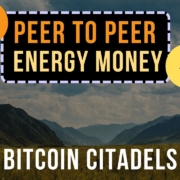Bitcoin Mining Difficulty Made Simple! | Hashpower Academy
Master one of Bitcoin Mining’s core Fundamentals in 12 Minutes!
Discover the fundamentals behind Bitcoin’s difficulty adjustment in this video. Learn how this key mechanism keeps block production steady, balancing the network’s energy use, data storage, and time to ensure stability and maintain Bitcoin’s scarcity. Perfect for anyone looking to grasp what makes Bitcoin tick!
Financial Disclaimer:
This video serves educational and informational purposes only and should not be construed as financial advice or investment recommendation. The views expressed are those of the presenter and do not represent Hashpower Academy’s official stance. Information is provided ‘as is’ without warranties, express or implied, as to its accuracy or completeness. Engaging with Bitcoin involves high risk, including potential financial loss, market volatility, and energy costs, and is suitable only for those who can bear these risks. Always conduct your own research and consult with a qualified financial or technical advisor before making decisions related to Bitcoin.
#Bitcoin
#BitcoinMining
#BitcoinDifficultyAdjustment
Video Transcript:
hello there and welcome to the hash power Academy my name is Jake scanland I’m the lead educator here at the Academy and this is a place to learn anything to do with Bitcoin and everything to do with Bitcoin starting with the fundamentals this is where we start with all the energy sector side of things electricity converted in Bitcoin miners to produce hash rate which produces Bitcoin blocks and this brings us to the topic of the difficulty adjustment the true test of your Bitcoin knowledge the final exam the litmus test in other places as they refer to it and the difficulty adjustment represents the uh what I like to call dimensional axis uh x y and Zed where they meet in the middle and those different components are what I like to call Energy space and time those are the three key things to understand about the difficulty adjustment even if it’s a bit of a technical thing that you’ve not still wrapped your head around at least understand the three key reasons why we’ll start with time time the the Bitcoin Network wants to regulate the amount of blocks per day per well any period of time it’s trying to create a steady state of 144 blocks per day and that is approximating 10 minutes per block but on the network you can have 20 blocks found in an hour or you could have one block found in an hour but the average across the entire pole of all the miners is reaching a steady state equilibrium at about 10 minutes per block and the network in terms of the code the code is looking back 2016 blocks so if you do 2016 by 144 you get to 14 2 weeks so the network is constantly looking back at the the amount of time it takes for blocks to be found over two we period of what it thinks it’s two weeks two weeks as in 2016 blocks and what is it observing the amount of hash rate producing blocks I hope you’re with me still and the three key reasons are it’s trying to regulate time to 144 blocks per day why because the steady state is that right now the amount of Bitcoin being issued the energy aspect is 450 Bitcoin per day 144 blocks in time per day 450 Bitcoin in terms of energy issuance digital energy per day and space is well every block stores transaction information ones and zeros per day now if 10% more hash rate come online then it’s not going to be 144 that’s going to be plus 10% in terms of that relative period of time the blocks are no longer going to be every 10 minutes they’re going to be approximating every 9 minutes and it’s the same with the amount of Bitcoin that’s going to be 400 that’s going to be 10% more Bitcoin being issued per day relative to that period of time and there’s 10% more block space in terms of uh if there’s more blocks there’s more Bitcoin being issued more space for transactions and um well blocks going to be every 9 minutes so energy data space and time now they all sound like reasonable things oh more more more time to or quicker transaction settlement more Bitcoin being issued and um more space for transactions to be stored energy space and time but those aren’t good things for the reason that well if this was 50% then uh we’d be at 288 blocks per day and it would be 900 Bitcoin per day so the inflation rate would be double and right now the Bitcoin inflation rate annually is it’s approximating 0 uh 78% I believe which is over half that of gold gold tries to average at 2% a year and we’re are the inflation rate of Bitcoin is is over half of that so if the network was to double in this example double in size which isn’t going to happen overnight we we don’t think and that’s going to be 50% as well well it would be uh those blocks would be found in a week at twice the amount of blocks per day it would be 10 minutes per block and twice as much Bitcoin and the inflation rate in that relative time would double and we don’t want to increase the inflation of the scarce hard digital money and it’s the same where there’ be twice as much block space so what happens is the node storing all that data would be on an accelerated without the difficulty adjustment the nodes would have to have twice as much storage space and they are volunteers nodes are volunteers they are not uh being paid for what they do and we don’t want to impose more storage costs at a quicker rate than they already know what the rate of the the Bitcoin network uh data size is growing at we don’t want to impose more cost on the volunteers that keep Bitcoin digitally decentralized now uh on the issuance inflation side of things we don’t want to inflate Bitcoin at a higher rate it’s already got the lowest inflation rate across all of the different monetary assets or Monet monetary Metals should we say um and yeah we don’t want to make blocks any less than 10 minutes because it’s a synchronization issue if uh a Bitcoin miner finds the block he screams out to the network I found a block here is my proof my proof of work he found the the the uh the correct amount of zeros and yeah well if it’s every five minutes there is more of a problem that not everyone’s going to get out that information um at the right the synchronization issues basically and so the difficulty adjustment is constraining uh the amount of energy issuance compute space that’s available by constraining time and so it’s this uh invention of time and why the difficulty adjustment has to constrain time is uh we’re not using the Bitcoin code doesn’t just randomly pull an API and go oh hey random website what’s the price or uh even an atomic clock the system is designed to not trust any one thing when it comes to decentralizing the issuant power hash rate distributed to all the Bitcoin miners all around the planet it’s constraining um energy as in the amount of issuance of the money and the block space if we have small blocks and uh a constrained amount of pace between each block if if blocks are found faster the fees on the on the fee rates will will drop but that fee rate keeps Bitcoin um the economics of using the fee Market competitive for the reasons that it subsidy inevitably drops out into Oblivion to zero and the amount of fees is going to become that Natural Market of buyers on the other side and they are in reference paying for the security of multiple gws an entire country’s worth of energy and compute protecting their transaction integrity and so the difficulty adjustment truly represents that that that point of energy space and time being regulated at the rate of energy ISS issuance data Space by time and the the pace of blocks being found all constrained together and it works by continually every block that’s found uh is time stamped the amount of time between each block is timestamped and so the so the the issuance of who is submitting what the time is on the network is uh is is recorded essentially and so that that gap of time between each each block is measured over the the previous two weeks approximately or 2016 blocks so if those 2016 blocks are found in quicker than 2 weeks the network adjusts it to to realign it back to every 10 minutes so it’s all this interplay of dimensions of energy space and time but what it does is it constrains the money to not be issued too quickly the storage space doesn’t collapse the price of the fee Market which is the competitive side of uh consumption on the Bitcoin blockchain and it all does it by by regulating time and essentially Bitcoin is a decentralized clock because it’s it’s not pulling the time from one particular place it’s not trusting any one particular person it’s sourcing the time from all the different uh people that have have captured their their share of the block rewards by finding a block and submitting time in the process so it’s uh yeah it’s quite a lot and um but it’s fundamental but it gets better it gets a lot better so when you circulate the system the blockchain and the difficulty adjustment creates uh a Time the the Bitcoin blocks being regulated in time so that the pace of issuance and data storage space and energy are all constrained together it forms pricing system so the conversion efficiency of Bitcoin miners the uh data market of how much Bitcoin for per storage space that you’re paying for and both of these two components create a new pricing system system for Bitcoin against energy and it’s actually very circular so we produce energy on electrical grids consume it in homes and Bitcoin miners who convert that into hash rate which export that energy onto the internet to produce hash power which adds the Bitcoin blocks which to this discussion that constraint of energy space and time ensures that the blockchain has the right amount of time of between blocks the right amount of issuance of Bitcoin so it’s not too fast not too slow and uh and that competitive fee Market aspect thing of storage space we don’t want to impose costs on the nodes they are the volunteers of the network we want as many nodes as possible so I recommend you uh get some uh large multi-terabyte ssds and uh and and save your own copy and version of the uh of the Bitcoin blockchain and so yeah Bitcoin creates this digital side of things of an energy space and time sort dimensional axis and the Bitcoin code uh keeps the regulation of all of this but it’s not in one single place again we’re not trusting one single place it’s distributed and copied across every single person running their own node and essentially um Bitcoin miners are energy nodes Bitcoin wallets are economic nodes and uh someone that has a full copy of the the file they are space nodes or something like that and uh yeah so there I hope this was an interesting video I’m going to do more sort of uh trying to break down the more technical side of things but the the difficulty adjustment is uh is quite a knot to crack as they say I hope you enjoyed this video like subscribe share drop anything in the comments I’ll probably do another difficulty adjustment video because um yes continually seeking to improve uh Kaizen as they like to say goodbye








![The Big Picture Basics [Lesson: 1/24] Energy Fundamentals The Big Picture Basics [Lesson: 1/24] Energy Fundamentals](https://hashpower.academy/wp-content/uploads/2025/07/The-Big-Picture-Basics-Lesson-124-Energy-Fundamentals-180x180.jpg)





Leave a Reply
Want to join the discussion?Feel free to contribute!